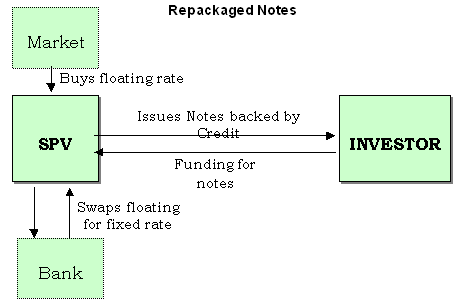
Personal Website of R.Kannan
Learning Circle - Trading in Derivatives
Repackaged Notes

Personal Website of R.Kannan |
| Home | View Table of Contents | Feedback |
Back to First-Page to View Table of Contents |
19. Repackaging involves placing securities and derivatives in a Special Purpose Vehicle (SPV) which then issues customized notes that are backed by the instruments placed. SPV can be incorporated either locally or offshore. 20. The difference between repackaged notes and CLDs (Credit Linked Deposits) is that while CLDs are default swaps embedded in deposits/notes, repackaged notes are issued against collateral - which typically would include cash collateral (bonds / loans / cash) and derivative contracts. Figure 5 below pictorially depicts the transactions under a Repackaged Note.  21. Repackaging involves incurring of initial set-up costs (of the SPV) and an additional transaction cost, but that cost is more often than not justifiable, given the tailor-made investment that the investor can make. 22. Another feature of Repackaged Notes is that any issue by the SPV has recourse only to the collateral of that issue. 23. The motivation behind repackaging is to offer the investor a customized product. Securities may have certain attractive features and other not-so-attractive features. Repackaging helps eliminate these not-so-attractive features. For example, a security may be unappealing because of denomination in an inaccessible currency, or because of absence of a liquid market or simply because the interest rate risk may not be in the form the investor wants. Repackaging through an SPV helps eliminate these unappealing features. Repackaged Notes, being clearable through recognised clearing systems can have greater liquidity and better delivery facilities. 24. In summary, the main benefits of using repackaged notes are:
25. CDOs are specialized repackaged offerings that typically involve a large portfolio of credits. Both involve issuance of debt by a SPV based on collateral of underlying credit(s). The essential difference between a repackaging programme and a CDO is that while a simple repackaging usually delivers the entire risk inherent in the underlying collateral (securities and derivatives) to the investor, a CDO involves a horizontal splitting of that risk and categorizing investors into senior class debt, mezzanine classes and a junior debt. CDO may be subject to local debt registration / regulatory requirements. The transactions under a CDO is shown in figure 6. 
Collateralised Debt Obligations. Explanation of Related Terms Sponsor: Senior Debt: Mezzanine Debt: Equity: The balance funding, which has the highest risk weight, or the lowest rated debt. 27. CDOs may be further categorized, based on the structure with which funding is raised. The funding could be raised by issuing bonds, which are called Collateralised Bond Obligations (CBOs) or by raising loans, which are called Collateralised Loan Obligations (CLOs). 28. Since the underlying credit is not a single asset but a portfolio of assets, the risk that it carries is a composite risk. To elucidate, some assets may have greater credit risk than others and there is a degree of correlation that each asset has with other assets in the portfolio. This means that the probability and timing of default/ downgrade could vary. Also, the cash flows from each of the assets are not uniform. This presents with a new risk, which is reinvestment. To put it differently, it is possible to issue debt with different risk weights, which means that it is possible to sell senior and mezzanine levels of debt. Also, there is an equity component, which may be sold off or retained by the sponsor. Benefits and Uses of CDOs 29. The most important benefit of a CDO is that the underlying portfolio can be sliced into various risk categories and can be sold to different investors who have different risk appetites. There is a first loss tranche of the portfolio that has the greatest risk of default and also therefore, the highest yield. As the risk diminishes, the yield diminishes. Banks find it very convenient to sell off entire portfolios to investors having different risk appetites by having different tranches, rather than selling investments individually. |
|